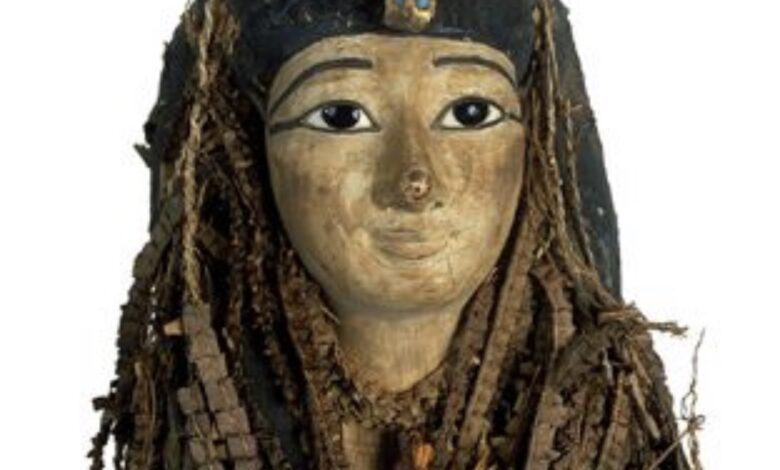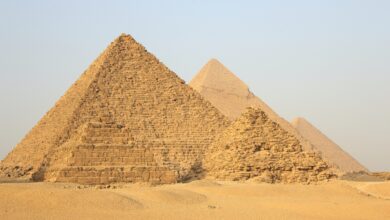
The secrets of the mummy of King Amenhotep I remained hidden under the scrolls and the funeral face mask until it was recently revealed in the scientific study published on December 28, 2021 in the Frontiers in Medicine journal by the famous Egyptologist and former Minister of Antiquities Zahi Hawass, and Professor of Radiology at the Faculty of Medicine at Cairo University Sahar Selim.
Hawass and Selim used advanced x-ray technology from computed tomography and advanced computer software to decouple the mummy of Amenhotep I in a safe digital manner without the need to touch the mummy.
The Egyptian study revealed for the first time the pharaoh’s age and health, in addition to many secrets of the mummy’s mummification and reburial.
The mummy of King Amenhotep I, the funerary mask, is the icon of the majestic royal mummies procession, transferred from the Egyptian Museum in Tahrir Square to the National Museum of Egyptian Civilization in Fustat in early April.
King Amenhotep I is the son of King Ahmose, conqueror of the Hyksos, who took the throne of Egypt after his father and ruled the country for twenty-one years from 1525 to 1504 BC as part of the 18th Dynasty in Egypt.
The mummy of King Amenhotep I was found in 1881 in the royal Deir el-Bahari in Luxor, where the priests of the twenty-first dynasty reburied and hid the mummies of many kings and princes to protect them from tomb robbers.
After their transfer to Cairo, all the royal mummies were unwrapped between 1881 and 1896, except for the mummy of King Amenhotep I.
The royal mummy has not been unwrapped like other mummies in order to preserve the beauty of the mummy’s cover which is topped with a funerary mask and wreaths of colorful flowers.
The face of the owner of the mummy and the information about him remained trapped in the scrolls and behind the royal mask until the scientific study was recently published in the prestigious scientific journal Frontiers in Medicine.
Hawass and Selim examined the mummy of King Amenhotep I using a computerized tomography (CT) machine located in the garden of the Egyptian Museum in Cairo.
The two Egyptian scientists used modern techniques of CT scans to remove the scrolls from the mummy of King Amenhotep I, by default, safely by computer programs and without affecting the mummy. This technique preserved the mummy intact, unlike the old method of unwinding the coils with actual suspicion, which exposed mummies to damage.
Hawass explained that the study succeeded for the first time in more than 3,000 years to remove the scrolls by computer from the face of King Amenhotep I, who turned out to be very similar to his father, King Ahmose I, preserved in the Luxor Museum.
The study accurately determined the age of King Amenhotep I at the time of death and estimated it to be 35 years old.
The study also predicted the king’s good health condition, suspecting no diseases or injuries on the mummy that predicted the cause of his death.
The study revealed exciting information about the distinctive embalming method of King Amenhotep I, as it became clear that the position of the crossed forearms on the body of the mummy of kings (which is called the Osiris position) began with the mummy of King Amenhotep I. This Osiris situation was not seen in kings who preceded Amenhotep I, and continued after him in the kings of the modern kingdom.
According to Selim, the study proved that the brain was still present in the skull of King Amenhotep I and was not removed during the mummification process, unlike most of the kings of the modern kingdom such as Tutankhamun and Ramses II and others, where the brain was removed and embalming materials and resins were placed inside the skull.
The accurate three-dimensional radiographs in the study revealed the presence of 30 amulets inside the mummy and between its coils, as well as the presence of a belt under the back of the king’s mummy consisting of 34 gold beads.
The study revealed the precise technique of ancient Egyptians in making the mummy’s funeral mask and placing precious stones on it, and unveiled for the first time, the secrets of the treatment of royal mummies by priests of the 21st Dynasty who re-buried royal mummies in two royal caches in the Valley of the Kings and Deir el-Bahari.
Placing golden ornaments during the reburial of royal mummies to preserve them ruled out allegations that the aim of reburial was to steal the ornaments and valuables from the mummies of ancient kings to be reused by the kings of the 21st Dynasty.
The study proved the great care given by the priests of the 21st Dynasty in re-burying the mummy of King Amenhotep I, by preserving the golden ornaments, and placing many amulets inside the mummy.
Hawass and Selim used CT scans to examine 40 royal mummies from the New Kingdom as part of the Royal Mummies Project of the Egyptian Ministry of Antiquities, which began in 2005 and continued until now.
One of the important results of the project is the disclosure of the secrets of the killing of King Ramses III in the conspiracy of the harem and the killing of King Seqenen Ra in the Battle of Egypt’s Silk by the Hyksos invaders.



